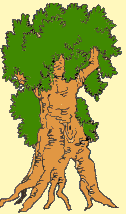DICHROSTACHYS CINEREA
DICHROSTACHYS CINEREA
DICHROSTACHYS CINEREA
Wolof: Sinké GOUN and FON: Abadawen or badawen; English: Mimosa clochette.
It is a small thorny tree 4-7m high with a branchy bottom, fine foliage, easily identifiable in flower. The bark is gray, cracked, braided in appearance, fibrous, coming off in strips with white yellow slices. The twigs are purplish brown, lenticellate white, pubescent with straight thorns, with a black top, solitary placed above the base of the leaves, up to 10cm long, and carrying 1 to 2 leaves. The leaves are alternate, bipinnately 5-15cm long, with 8-15 pairs of pinnae and 10-25 pairs of leaflets per pinna. The petioles pubescent, carry a stipitate gland at the base of each pair of pinnae. The fruit is a bundle of pods curled upon themselves, yellow or brown, indehiscent containing 4 to 5 seeds, persisting for a long time on the tree.
Flowering takes place in the second part of the dry season, before the appearance of the first leaves, and it is a Sahelo-Sudanese to Guinean species that grow on heavy soils, invading disturbed places (fallow land, road embankments). meets from Senegal to Cameroon, to Sudan, tropical and southern Africa. Locally abundant and gregarious commune.
Medicinal Uses: The roots are diuretic, deworming, and antivenom. They are used for the treatment of rheumatism, gonorrhea, abscess, and infant cough. The association of roots and leaves is used for tooth decay and gingivitis. The barks are centrifuge and enter into the composition of recipes to treat gonorrhea and elephantiasis. The leaves are effective against eczema and the fruits against ear infections, umbilical hernia, and malaria in children.
Other Uses: The bark is used for bovine foot-and-mouth disease. Its hard, yellow to light brown wood is termite resistant and is used for making stakes and tool handles. It is also excellent fuelwood and charcoal. The stems are used for making baskets
Add a comment























